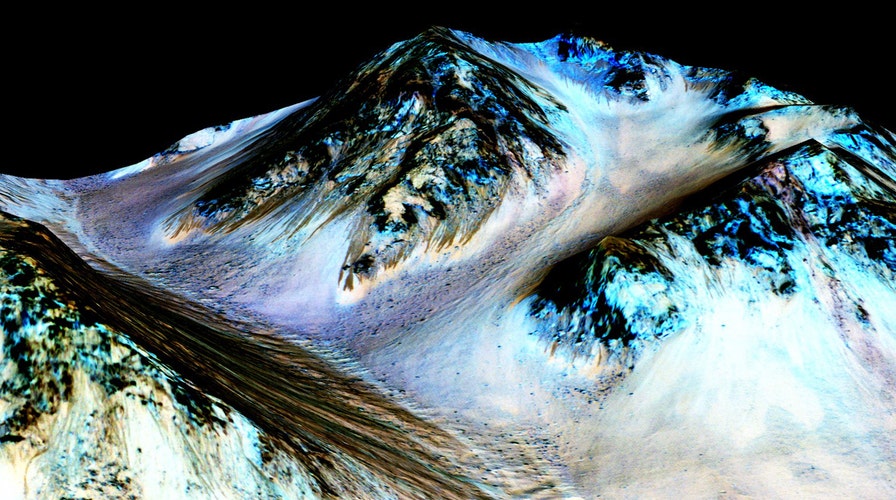Is reality surpassing science-fiction on Mars?
Foxnews.com SciTech: Chris Carberry on how 'The Martian' and recent discovery of liquid water on Mars could impact public policy towards space travel
Billions of years ago, there were lakes shimmering on Mars.
That is the conclusion from the team behind NASA's Mars Science Laboratory/Curiosity, who used data from the Curiosity rover to determine that water helped deposit sediment into Gale Crater. Three years ago, the rover landed at the crater and it has been exploring the area ever since.
"Observations from the rover suggest that a series of long-lived streams and lakes existed at some point between about 3.8 to 3.3 billion years ago, delivering sediment that slowly built up the lower layers of Mount Sharp," said Ashwin Vasavada, Mars Science Laboratory project scientist at NASA's Jet Propulsion Laboratory in Pasadena, Calif, and co-author
of the new Science article to be published Friday, in a press release.
The findings build upon previous work that suggested there were ancient lakes on Mars and offers the latest proof that the Red Planet was wet. Last month, NASA scientists confirmed that water flowed on Mars.
Related: Supermoon lunar eclipse in pictures
"What we thought we knew about water on Mars is constantly being put to the test," said Michael Meyer, lead scientist for NASA's Mars Exploration Program at NASA Headquarters in Washington, in a press release. "It's clear that the Mars of billions of years ago more closely
resembled Earth than it does today. Our challenge is to figure out how this more clement Mars was even possible, and what happened to that wetter Mars."
The findings of a wet planet don’t exactly match up with models developed by paleoclimatologists – a similar conundrum in trying to understand Earth’s ancient past.
“Aside from the shapes of the continents, geologists had paleontological evidence that fossil plants and animals in Africa and South America were closely related, as well as unique volcanic rocks suggestive of a common spatial origin," John Grotzinger, the former project scientist for Mars Science Laboratory at the California Institute of Technology in Pasadena, and lead author of the new report, in a press release. “The problem was that the broad community of Earth scientists could not come up with a physical mechanism to explain how the continents could plow their way through Earth’s mantle and drift apart. It seemed impossible. The missing component was plate tectonics. In a possibly similar way, we are missing something important about Mars.”
Related: NASA spacecraft discovers blue sky, red ice on Pluto
In mid-September 2014, the rover reached the foothills of Aeolis Mons, a three-mile-high layered mountain nicknamed “Mount Sharp” in honor of the late Caltech geologist Robert Sharp. Curiosity has been exploring the base of the mountain since then.
Before Curiosity landed on Mars in 2012, scientists proposed that Gale Crater had filled with layers of sediments. Some hypotheses were "dry," suggesting that sediment accumulated from wind-blown dust and sand. Others focused on the possibility that sediment layers were deposited in ancient lakes.
Based on the new analysis, the filling of at least the bottom layers of the mountain occurred mostly by ancient rivers and lakes over a period of less than 500 million years.
"During the traverse of Gale, we have noticed patterns in the geology where we saw evidence of ancient fast-moving streams with coarser gravel, as well as places where streams appear to have emptied out into bodies of standing water," Vasavada said. "The prediction was that we should start seeing water-deposited, fine-grained rocks closer to Mount Sharp. Now that we've arrived, we're seeing finely laminated mudstones in
abundance that look like lake deposits."
The mudstone indicates that the lakes may have been around for some time, the presence repeatedly expanding and contracting during hundreds to millions of years.
"Paradoxically, where there is a mountain today there was once a basin, and it was sometimes filled with water," Grotzinger said, in the press release. "We see evidence of about 250 feet (75 meters) of sedimentary fill, and based on mapping data from NASA's
Mars Reconnaissance Orbiter and images from Curiosity's camera, it appears that the water-transported sedimentary deposition could have extended at least 500 to 650 feet (150 to 200) meters above the crater floor."
But where did the water come from?
For flowing water to have existed on the surface, Mars must have had a thicker atmosphere and warmer climate than has been theorized for the ancient era when Gale Crater experienced the intense geological activity.
At least some of the water may have been supplied to the lakes by snowfall and rain in the highlands of the Gale Crater rim. Some have made the argument that there was an ocean in the plains north of the crater, but that does not explain how the water managed to exist as a liquid for extended periods of time on the surface.
"We have tended to think of Mars as being simple," Grotzinger said. "We once thought of the Earth as being simple too. But the more you look into it, questions come up because you're beginning to fathom the real complexity of what we see on Mars. This is a good
time to go back to reevaluate all our assumptions. Something is missing somewhere."
As scientists work to develop better atmospheric models, help solving that riddle should come as Curiosity continues to climb Mount Sharp in the years to come.
“There are still many kilometers of Mars history to explore,” said Woody Fischer, professor of geobiology at Caltech and coauthor of the paper, in a press release. “The strata will reveal Gale’s early history, its tory. We know there are rocks that were deposited underwater, in the lake. What is the chemistry of these rocks? That lake represented an interface
between the water and the atmosphere, and should tell us important things about
the environment of the time.”

